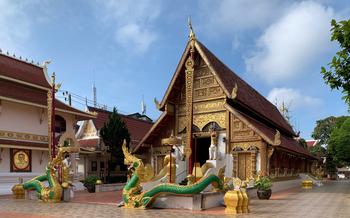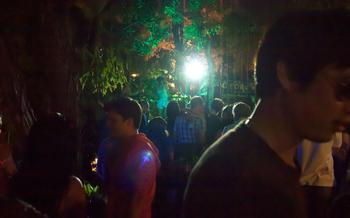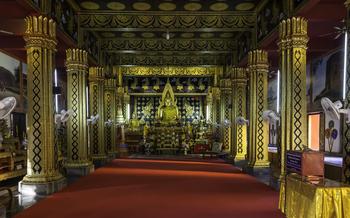
Wat Nantaram
- Architectural Marvel
- Ancient Inscriptions
- Ordination Hall
- Buddha Images
- Monastic Life
- Community Involvement
- Pilgrimage and Tourism
- Visiting Information
- Photography Tips
- Insider Tip: Uncover the Secret Chamber
Architectural Marvel
Wat Nantaram's architectural style is a testament to the craftsmanship and creativity of ancient Lanna builders. The temple's layout follows the traditional Lanna Buddhist temple design, featuring a central ordination hall (viharn) flanked by two smaller buildings, the library (ho trai) and the drum tower (ho keng). The ordination hall, the most sacred structure in the temple, is a rectangular building with a three-tiered roof that rises gracefully towards the sky. The roof is supported by massive teak pillars adorned with intricate carvings depicting mythical creatures and scenes from Buddhist mythology. The exterior walls of the ordination hall are decorated with colorful murals depicting the life of Buddha and other Buddhist stories. The murals are a testament to the skill and artistry of the Lanna painters and have been meticulously preserved over the centuries.
Ancient Inscriptions
Wat Nantaram is home to a collection of ancient inscriptions that hold immense historical and cultural significance. These inscriptions are etched onto stone tablets and pillars scattered throughout the temple grounds, providing valuable insights into the temple's history, religious beliefs, and cultural practices of the time.
The inscriptions were created using various techniques, including carving, engraving, and stamping. The scripts used are a mix of ancient Thai and Pali, the sacred language of Buddhism. The content of the inscriptions ranges from religious teachings and historical records to royal decrees and land grants.
One of the most notable inscriptions found at Wat Nantaram is the "Nantaram Inscription," which dates back to the 15th century. This inscription provides a detailed account of the temple's construction and the motivations of its builders. It also mentions the names of the craftsmen and artisans who worked on the temple, shedding light on the artistic and cultural traditions of the period.
Interpreting these ancient inscriptions can be challenging due to their age, the fading of the scripts, and the complexities of the languages used. Scholars and historians have dedicated extensive research to deciphering and understanding these inscriptions, contributing to our knowledge of Wat Nantaram's rich history and its place in the cultural and religious landscape of Thailand.
Ordination Hall
The ordination hall at Wat Nantaram stands as a testament to the temple's significance as a center of Buddhist monastic life. Its architectural features reflect the sacred purpose of the space, with a spacious interior designed to accommodate the solemn ceremonies that take place within. The hall is supported by massive pillars that create a sense of grandeur, while the intricate carvings on the walls and ceiling depict scenes from the life of Buddha and other significant events in Buddhist history.
The ordination hall serves as the stage for one of the most important rituals in Buddhism: the ordination of new monks. During these ceremonies, young men and women make a formal commitment to the monastic life, embracing the teachings of Buddha and pledging to follow the path of enlightenment. The ordination hall is transformed into a sacred space, imbued with the energy of devotion and spiritual transformation.
Buddha Images
Wat Nantaram is home to a diverse collection of Buddha images, each with its own unique characteristics and significance. The most prominent Buddha image is the Phra Chao Thong Thong, a large bronze Buddha statue seated in the viharn's central chamber. The image is highly revered by local Buddhists and is believed to date back to the 15th century.
Other notable Buddha images include the Phra Chao Lan Thong, a smaller bronze Buddha statue seated in the ordination hall, and the Phra Chao Nang Phaya, a white marble Buddha image enshrined in the temple's main chedi. These images are all exquisitely crafted and display distinct features, such as different postures, mudras, and expressions.
The Phra Chao Thong Thong is depicted in the classic bhumisparsha mudra, symbolizing Buddha's calling the earth to witness his triumph over Mara, the demon of temptation. The Phra Chao Lan Thong is shown in the subduing Mara mudra, representing Buddha's victory over evil forces. The Phra Chao Nang Phaya is in the abhaya mudra, conveying a message of peace and protection.
Visitors to Wat Nantaram are often drawn to the serene and spiritual presence of these Buddha images. They are a testament to the temple's rich history and artistic legacy and continue to inspire devotion and reverence among Buddhists and visitors alike.
Monastic Life
Within the serene confines of Wat Nantaram, a community of dedicated monks leads a life of devotion and discipline. The monks rise before dawn, their day beginning with meditation and chanting. They then embark on a daily alms round, collecting food offerings from the local community. This practice not only sustains the monks but also fosters a strong bond between the temple and the surrounding neighborhood.
After the alms round, the monks return to the temple to partake in communal meals and engage in religious studies. They spend their afternoons tending to the temple grounds, preserving its historical treasures, and offering guidance to visitors. The monks also conduct regular meditation sessions, open to both residents and visitors seeking spiritual growth.
One of the most significant events in the monastic calendar is the ordination ceremony. This sacred ritual marks the formal initiation of new monks into the Buddhist order. The ordination hall, with its intricate carvings and serene atmosphere, serves as the stage for this momentous occasion. The monks of Wat Nantaram play a pivotal role in guiding and supporting the newly ordained monks as they embark on their spiritual journey.
The presence of these dedicated monks infuses Wat Nantaram with a palpable sense of spirituality and reverence. Their unwavering commitment to monastic life serves as an inspiration to visitors, offering a glimpse into the profound teachings and practices of Buddhism.
Community Involvement
Wat Nantaram plays a vital role in the local community, extending its reach beyond spiritual guidance. The temple serves as a hub for education, healthcare, and various social services, fostering a sense of unity and support among the community members.
The monks residing at Wat Nantaram are actively involved in providing education to the local children, offering classes in both religious and secular subjects. The temple also operates a healthcare clinic, providing basic medical care and assistance to those in need. Additionally, the temple organizes regular community events and festivals, bringing people together to celebrate their shared heritage and traditions.
Community support is essential for the upkeep and maintenance of Wat Nantaram. The temple relies on donations from the local community to cover the costs of repairs, renovations, and daily operations. In return, the temple provides a safe and welcoming space for community gatherings, religious ceremonies, and social events, strengthening the bonds between the temple and its surrounding community.
Pilgrimage and Tourism
Wat Nantaram holds a significant position as a pilgrimage site for Buddhists and visitors alike. Devout Buddhists from across Thailand and neighboring countries embark on pilgrimages to pay homage to the sacred Buddha images and relics enshrined within the temple's walls. The temple's serene atmosphere and rich spiritual energy attract pilgrims seeking a deeper connection with their faith and a chance to immerse themselves in Buddhist teachings.
Apart from its religious significance, Wat Nantaram is also a popular destination for cultural and historical enthusiasts. Its unique architectural style, exquisite artwork, and ancient inscriptions draw visitors who appreciate the beauty and heritage of Thailand's sacred sites. The temple's well-preserved condition and the dedication of the local community in preserving its legacy make it a must-visit destination for anyone interested in Thailand's cultural and religious history.
The impact of tourism on Wat Nantaram has been generally positive. The revenue generated from tourism helps fund the temple's upkeep and conservation efforts, ensuring its preservation for future generations. Additionally, tourism promotes cultural exchange and understanding, allowing visitors to learn about Buddhism and Thai culture while contributing to the local economy.
To cater to the needs of pilgrims and tourists, Wat Nantaram offers various facilities and services. Visitors can find comfortable accommodation in nearby guesthouses or hotels, and there are several restaurants and shops in the vicinity offering a range of local and international cuisine. The temple also provides guided tours for visitors who wish to learn more about its history and significance, making it an accessible and welcoming destination for all.
Visiting Information
If you're planning a visit to Wat Nantaram, here's some practical information to help you make the most of your experience:
Location: Wat Nantaram is located on the banks of the Ing River in Phayao, Thailand. The temple is easily accessible by car or public transportation.
Transportation: The most convenient way to reach Wat Nantaram is by taking a tuk-tuk or songthaew (shared taxi) from the city center. You can also rent a bicycle or motorbike to explore the area at your own pace.
Admission: Admission to Wat Nantaram is free of charge. However, donations are welcome to help support the temple's upkeep and restoration efforts.
Best time to visit: The best time to visit Wat Nantaram is during the dry season (November to April) when the weather is pleasant and sunny. During the rainy season (May to October), the temple grounds can become muddy and slippery.
Dress code: Visitors to Wat Nantaram are expected to dress respectfully. This means avoiding shorts, tank tops, and other revealing clothing. It's also important to remove your shoes before entering the temple's main sanctuary.
Photography Tips
To capture the beauty of Wat Nantaram through photography, it's important to consider the following tips:
-
Golden Hour Magic: Arrive at the temple during the golden hours of sunrise or sunset to take advantage of the soft, warm light that enhances the temple's architecture and surroundings.
-
Wide-Angle Perspective: Use a wide-angle lens to capture the temple's grandeur and scale. Experiment with different angles to create dynamic compositions that showcase the temple's intricate details.
-
Tripod Stability: Bring a tripod to ensure stability and avoid camera shake, especially when shooting in low-light conditions or using a telephoto lens.
-
Experiment with Angles: Don't be afraid to experiment with different angles and vantage points. Climb the temple's stairs or find elevated spots to capture unique perspectives.
-
Respect the Sacred: Remember that Wat Nantaram is an active place of worship, so be respectful of the monks and other visitors. Avoid using flash photography or making loud noises that may disturb their peace.
Insider Tip: Uncover the Secret Chamber
Beyond the main temple complex, tucked away in a secluded corner of Wat Nantaram, lies a hidden chamber that few visitors know about. This secret chamber houses a collection of ancient artifacts, including rare manuscripts, religious relics, and stunning Buddha images. To access the chamber, you must seek permission from the temple's abbot and be accompanied by a guide. The abbot holds the key to the chamber and will share fascinating stories and insights into the temple's history and the significance of these precious artifacts. This exclusive experience offers a glimpse into the temple's hidden treasures and provides a deeper understanding of its spiritual and cultural heritage.



